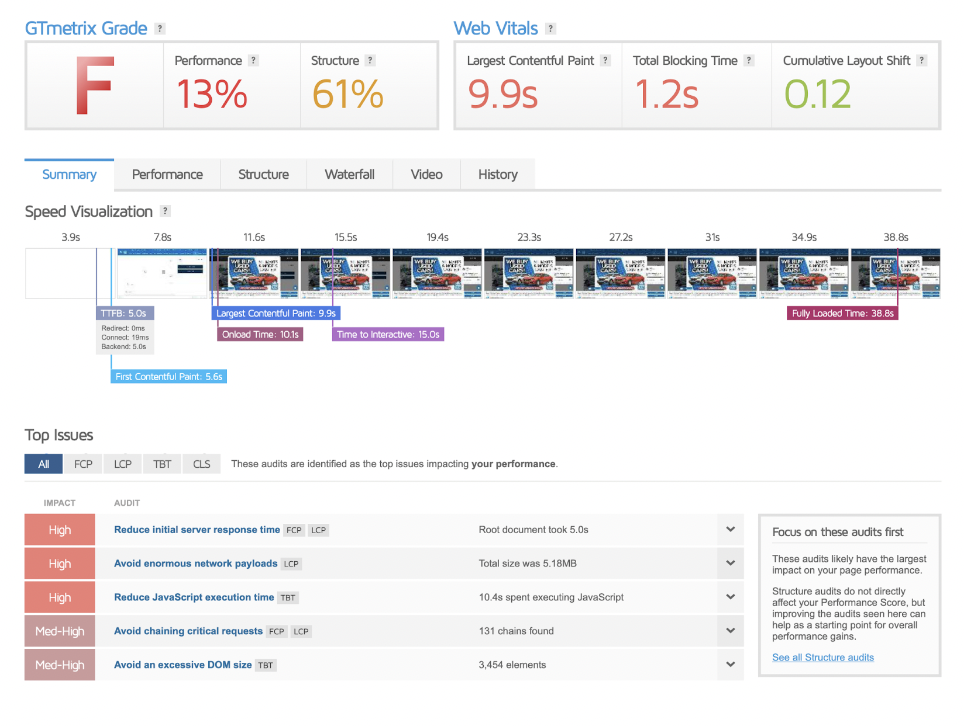Accelerate Conversions: The Crucial Role of Page Loading Speed for Dealership Websites
In the rapidly evolving world of digital automotive advertising, every second counts. Your dealership's website loading speed isn't just a technical detail – it's a game-changer that can make or break your online marketing efforts. With the increasing dependence on digital platforms and the growing impatience of users, the importance of a swift website experience cannot be overstated.
The Need for Speed: A Matter of Conversions
Imagine this scenario: a potential car buyer scrolls through their social media feed and stumbles upon your captivating Facebook or Google ad. Intrigued, they click the ad, eager to explore the vehicles your dealership has to offer. They're poised to convert, ready to take the next step. But then, frustration sets in as the website takes its sweet time to load – 10 seconds feel like an eternity. What happens next is predictable and problematic: the user abandons ship.
Here lies the crux of the matter: slow-loading dealership websites cost you conversions. In a digital landscape where instant gratification is expected, a delay of just a few seconds can lead to a significant drop in user engagement. Recent studies reveal that a staggering 53% of users will abandon a site if it takes longer than 3 seconds to load. As loading time inches towards 10 seconds, that abandonment rate can increase significantly.
The Ripple Effect on Marketing Campaigns
Now, let's connect the dots to your marketing campaigns. Whether you're driving traffic to your homepage, search results pages (SRPs), or vehicle details pages (VDPs), the bottom line remains the same: a slow website will sabotage your conversion rates. Here's how:
Wasted Ad Spend: Every click on your ad costs you money. When visitors bail due to slow loading speeds, you're essentially paying for lost opportunities. Your budget is being exhausted on visitors who never got to engage with your content. It’s hard enough to get shoppers to click an ad in the first place… losing them after they have committed because your site is too slow is unacceptable.
Lower Quality Scores: Search engines like Google factor in page loading speed when calculating the Quality Score of your ads. Slow-loading pages can negatively impact your Quality Score, leading to fewer placements, higher costs per click, and lower ad rankings.
Diminished User Experience: A sluggish website tarnishes the user experience, damaging your dealership's online reputation. Annoyed users are less likely to return or recommend your site, leading to a long-term loss of potential customers.
How to Recognize Slow Page Loading Speed
Your marketing agency will often provide you with reports explaining campaign performance. These reports often describe high-level metrics like impressions, clicks, click-through rates, conversion, conversion rates, and costs per conversion. One key metric that is often overlooked is clicks to sessions (CTS). This metric compares the number of clicks you received from an ad platform and how many corresponding sessions were created by those clicks in Google Analytics. Discrepancies occur when a shopper clicks an ad but does not actually land on your website and remain there long enough for the page to fully load and Google Analytics to record this visit.
Some discrepancy is normal and expected. If the same user clicks your ad more than once over say a 20 minute period, only the first click will create a session. So you will have received (and paid for) 2 clicks but recorded only a single session in Google Analytics. And some shoppers inadvertently click an ad and will hit the back button or close the window before your page loads. (Unfortunately, you are still paying for that click in most ad platforms.) However, in general, you should expect most of your ad clicks to land on your website and create sessions.
A small discrepancy of less than 15% is often considered normal. Anything above that should be investigated, as common reasons for a high click to session discrepancy will be user abandonment due to a slow loading page.
The simplest method is to ensure you visit your dealership website often. Look at the homepage, search results pages, model pages and a few VDPs. You should immediately get an initial sense if the site isn’t snappy and content doesn’t load quickly. If you feel it’s sluggish or slow, chances are so will potential customers that click on your ads.
Remember, too, that shoppers clicking ads are often delayed an extra second or two as the click is tracked and the user is directed to your website.
You can use a variety of simple free tools to perform more systematic tests on your website. Try Google’s PageSpeed tool or GTMetrix’s free site analyzer tool. Both tools allow you to enter your website URL and get a performance analysis.
Tip: Don’t just enter your homepage here. Be sure to test SRPs and VDPs as well. Homepages are often optimized to load the fastest since the assumption is users always go here first. That’s not the case anymore with many advertising products.
While there can be a lot of details you may not understand, these tools above give a simple high-level grade or score while showing you key information like how many seconds it takes until the first useful content appears to the user.
Google Page Speed Report:
GT Metrix Page Speed Report:
It is important to test your site more than once and over a period of time as performance issues can be intermittent and can creep up over time.
If you notice performance problems, contact your website vendor immediately and regularly to ensure they are upholding the standards you expect for page performance. Chances are they provided you with a service level agreement (SLA) that promises a certain performance level, and page speed should be included within that.
Try VIN IQ’s Free Marketing Analysis for your Dealership
Dealers can also leverage VIN IQ’s free Marketing Analysis to discover your dealership’s current marketing and website performance and uncover the details you need to increase visitor conversions. Get your free Marketing Analysis today.


